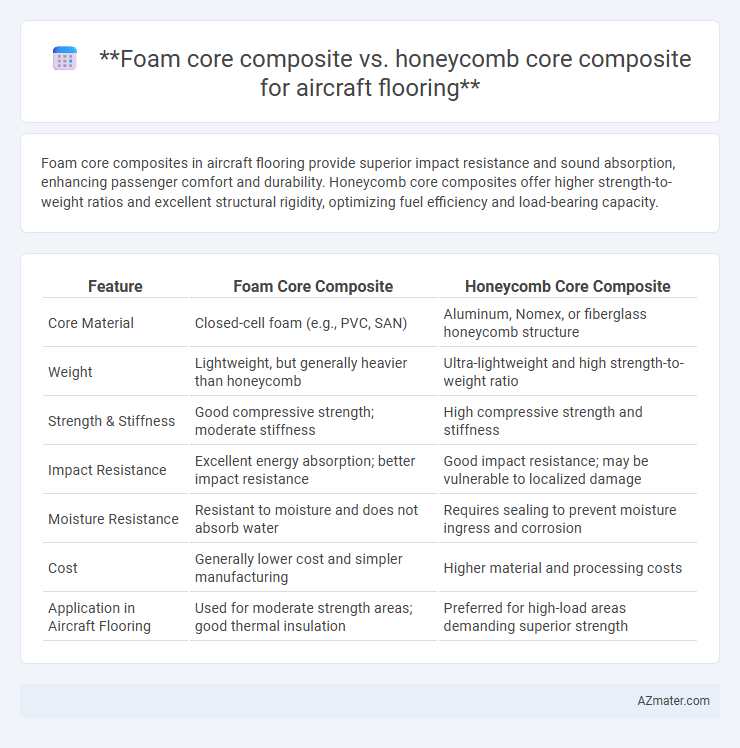Foam core composites in aircraft flooring provide superior impact resistance and sound absorption, enhancing passenger comfort and durability. Honeycomb core composites offer higher strength-to-weight ratios and excellent structural rigidity, optimizing fuel efficiency and load-bearing capacity.
Table of Comparison
| Feature | Foam Core Composite | Honeycomb Core Composite |
|---|---|---|
| Core Material | Closed-cell foam (e.g., PVC, SAN) | Aluminum, Nomex, or fiberglass honeycomb structure |
| Weight | Lightweight, but generally heavier than honeycomb | Ultra-lightweight and high strength-to-weight ratio |
| Strength & Stiffness | Good compressive strength; moderate stiffness | High compressive strength and stiffness |
| Impact Resistance | Excellent energy absorption; better impact resistance | Good impact resistance; may be vulnerable to localized damage |
| Moisture Resistance | Resistant to moisture and does not absorb water | Requires sealing to prevent moisture ingress and corrosion |
| Cost | Generally lower cost and simpler manufacturing | Higher material and processing costs |
| Application in Aircraft Flooring | Used for moderate strength areas; good thermal insulation | Preferred for high-load areas demanding superior strength |
Introduction to Aircraft Flooring Materials
Foam core composites and honeycomb core composites are widely used materials in aircraft flooring due to their high strength-to-weight ratios and durability. Foam core composites offer excellent impact resistance and sound insulation, while honeycomb core composites provide superior structural stiffness and energy absorption. Both materials contribute to weight reduction and enhanced safety in aerospace applications, optimizing performance and passenger comfort.
Overview of Foam Core Composites
Foam core composites for aircraft flooring consist of a lightweight, closed-cell foam core sandwiched between composite skins, offering excellent strength-to-weight ratio and impact resistance. These composites provide superior insulation properties and enhanced vibration damping, contributing to passenger comfort and structural integrity. Their ease of fabrication and cost-effectiveness make foam core composites a popular choice in aerospace applications compared to honeycomb core composites.
Overview of Honeycomb Core Composites
Honeycomb core composites for aircraft flooring consist of a lightweight, rigid core structure made from materials such as aluminum or Nomex arranged in a hexagonal pattern, providing high strength-to-weight ratios and excellent impact resistance. This structure enhances load distribution and structural integrity while maintaining minimal weight, critical for fuel efficiency and performance in aviation applications. Honeycomb cores also offer superior vibration damping and thermal insulation compared to foam core composites, making them a preferred choice in high-performance aircraft flooring systems.
Structural Performance Comparison
Foam core composites in aircraft flooring offer excellent energy absorption and lightweight properties, improving durability and passenger comfort. Honeycomb core composites provide superior stiffness-to-weight ratios and enhanced load-bearing capabilities, making them ideal for high-stress applications. Structural performance comparisons reveal honeycomb cores outperform foam cores in impact resistance and flexural strength, while foam cores excel in vibration damping and damage tolerance.
Weight and Density Analysis
Foam core composites used in aircraft flooring typically exhibit lower density values ranging from 80 to 200 kg/m3, resulting in reduced overall weight and enhanced fuel efficiency compared to honeycomb core composites, which generally have densities between 40 to 120 kg/m3 but require thicker cores to achieve similar stiffness. Honeycomb core composites offer superior strength-to-weight ratios due to their hexagonal cellular structure, providing higher crush resistance and impact tolerance, which can increase weight slightly but improve durability in high-load zones. Weight optimization in aircraft flooring design balances foam core's lightweight benefits with honeycomb core's mechanical performance, influencing aircraft payload capacity and operational efficiency.
Durability and Impact Resistance
Foam core composites used in aircraft flooring provide excellent impact resistance due to their energy absorption capabilities, while honeycomb core composites offer superior durability through their high stiffness-to-weight ratio and resistance to compression. The closed-cell structure of foam cores helps prevent moisture ingress, enhancing long-term performance under repeated stress, whereas honeycomb cores are more prone to damage from localized impacts but excel in structural load distribution. Selecting between foam and honeycomb core composites depends on balancing impact resistance priorities with durability requirements for specific flooring applications in aerospace environments.
Cost and Manufacturing Considerations
Foam core composites for aircraft flooring offer lower material costs and simplified manufacturing processes due to easier shaping and cutting compared to honeycomb core composites, which require meticulous cell structure fabrication and bonding. Honeycomb cores provide superior strength-to-weight ratios but drive up production time and expenses through complex assembly and quality control standards. Selecting foam core composites often reduces initial investment and labor, while honeycomb yields long-term performance benefits at a higher upfront cost.
Fire Safety and Certification Requirements
Foam core composites offer moderate fire resistance but may require additional fire-retardant treatments to meet aerospace fire safety certification standards such as FAR 25.853. Honeycomb core composites, often made from aluminum or Nomex, inherently provide superior fire resistance and thermal stability, facilitating compliance with stringent fire safety regulations. Certification agencies prioritize materials demonstrating low smoke toxicity, flame propagation resistance, and self-extinguishing properties, where honeycomb cores generally perform better for aircraft flooring applications.
Maintenance and Repairability
Foam core composites in aircraft flooring exhibit easier local damage repair due to their uniform structure, enabling quicker maintenance turnaround times and reduced labor costs. Honeycomb core composites, although lightweight and strong, require specialized techniques and materials for repairs, often resulting in longer downtimes and higher maintenance expenses. Choosing foam core composites enhances maintainability through straightforward patching and inspection, critical for efficient fleet operation and minimizing ground time.
Conclusion: Selecting the Optimal Core for Aircraft Flooring
Foam core composites offer lightweight properties with excellent impact resistance, making them suitable for areas requiring energy absorption in aircraft flooring. Honeycomb core composites provide superior stiffness-to-weight ratios and enhanced structural integrity, ideal for supporting heavy loads and ensuring floor durability. Selecting the optimal core depends on balancing weight, strength, and specific operational demands to achieve maximum performance and safety in aircraft flooring applications.

Infographic: Foam core composite vs Honeycomb core composite for Aircraft flooring
 azmater.com
azmater.com